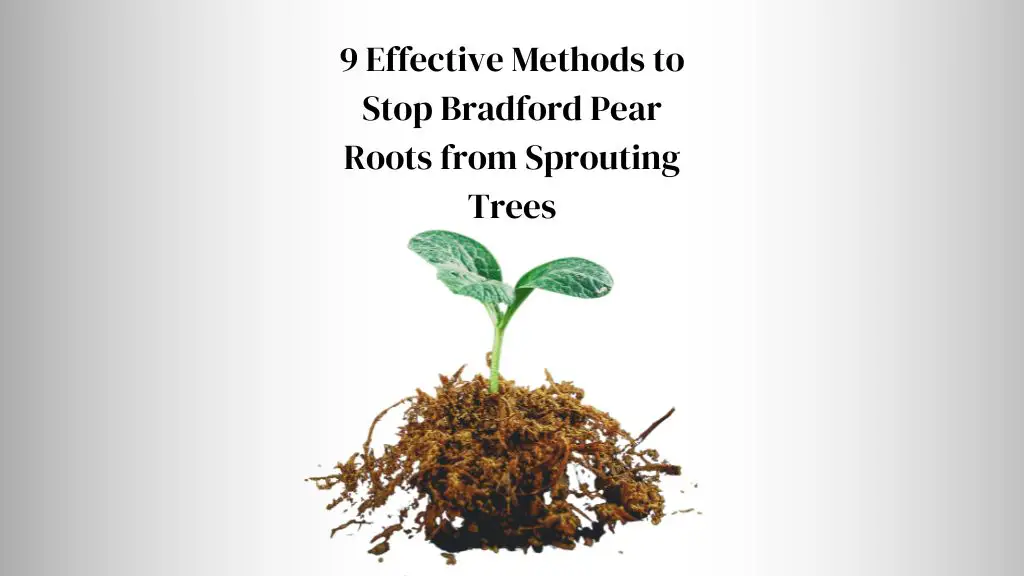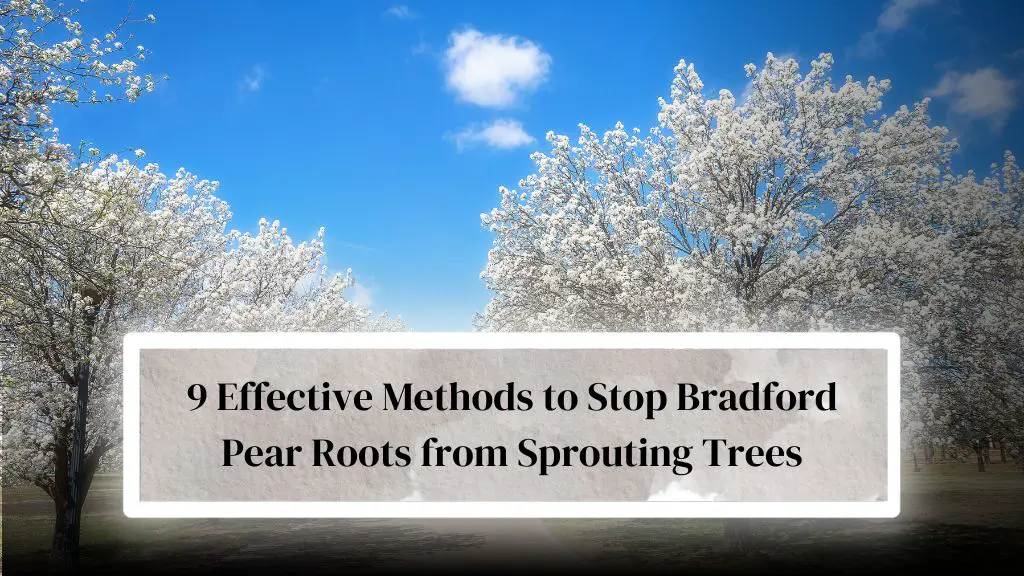
I have seen many homeowners and gardeners frustrated with Bradford pear trees, known for their beautiful spring blooms and rapid growth. To know “When Do Bradford Pear Trees Bloom?” Click here.
However, their root sprouts can quickly become a nuisance and lead to a thicket of trees that are difficult to manage. Therefore in this article, I’ll help you learn how to stop Bradford pear roots from sprouting trees. You should know that Understanding the problem is crucial in finding the right solution.
How to Stop Bradford Pear Roots from Sprouting Trees: 9 Effective Methods

Remove the Entire Tree
I recommend removing the entire tree when the root sprouts are widespread and unmanageable. This method is also suitable when the tree is damaged or diseased beyond repair.
Removing the entire tree eliminates the root system and any potential root sprouts. It also allows replanting the area with a more suitable tree species. To remove the tree, you need a chainsaw, safety gear, and some basic knowledge of tree removal. It is recommended to hire a professional arborist for safety reasons. Check this article, ” Bradford Pear Tree Removal Cost: 7 Factors That Affects Its Cost” to determine how much you should pay.
Complete removal of the tree and its root system is crucial in preventing further root sprouts from growing. Leaving the roots in the ground can lead to new trees sprouting from the remaining roots.
The tree can be cut up for firewood, mulch, or taken to a landfill. Some local municipalities may offer tree removal services, so it is worth checking with them. To know more, learn this: Is bradford pear good firewood?
Cut Back the Root Sprouts
Cutting back the root sprouts is a suitable approach when the root sprouts are not widespread and have yet to develop into full trees. This method requires regular maintenance to prevent new sprouts from growing.
Cutting back the root sprouts is a suitable approach for a moderate root sprout problem. It is also suitable when the homeowner wants to keep the tree and prevent further root sprouts.
It would be best to have a sharp pair of pruning shears or a pruning saw to cut back the root sprouts. Cut the sprouts as close to the ground as possible without damaging the main root system. It is best to cut the sprouts when small, as they are easier to manage. Regular cutting every few weeks can also prevent new sprouts from growing.
Use Herbicides
Using herbicides is suitable when the root sprouts are widespread and have become unmanageable. Herbicides can kill the root system, preventing new sprouts from growing. Using herbicides is a suitable approach for treating a severe root sprout problem.
It is important to use herbicides properly and safely to avoid harming other plants or animals in the area. Glyphosate and triclopyr are two common herbicides used to kill the root system of the Bradford pear tree.
It is important to follow the instructions on the label and wear protective gear when using herbicides. It is important to use herbicides properly and safely to avoid harming other plants or animals in the area.
Always follow the instructions on the label and wear protective gear when using herbicides. After using herbicides, it is important to monitor the area for any new growth and continue to cut back any root sprouts that appear.
Apply Root Barriers
Applying root barriers is a suitable approach for a moderate root sprout problem. It is also suitable when the homeowner wants to keep the tree and prevent further root sprouts.
Root barriers can be made from various materials, including plastic, metal, and fabric. It is important to choose a barrier that is appropriate for the situation and install it properly.
To install the barriers, dig a trench around the tree’s perimeter and insert the barrier material. Ensure that the barrier extends at least two feet below and above the ground level.
Regular maintenance of the barriers is necessary to ensure that they remain effective. Check the barrier periodically for any damage or breaches and repair it as necessary.
In conclusion, several effective methods exist to stop Bradford pear roots from sprouting trees. The best approach depends on the severity of the problem and the homeowner’s preferences. By understanding the problem and choosing the right method, homeowners can prevent further root sprouts and enjoy their garden without the frustration of unwanted trees.
Use Physical Barriers
Physical barriers are an excellent alternative when you want to stop new trees from growing in a particular region. These barriers, which form a physical barrier between the root system and the soil, are often made of materials like concrete, metal, or plastic.
Utilize physical barriers to stop Bradford Pear Roots from growing new trees in specific places like sidewalks, driveways, or foundation walls. You can employ a variety of obstacles to stop the spread of tree roots.
A root barrier, a thick, impermeable membrane that prevents the growth of roots, is one of the most well-liked forms. Another choice is to dig a trench and fill it with something impenetrable, like gravel, sand, or concrete.
Physical barrier installation is a simple procedure. You must first locate the location where the new trees are sprouting. The barrier material should next be positioned, extending at least two feet below the soil’s surface, in a trench dug around the area’s perimeter.
It’s crucial to routinely inspect the barrier for potential fractures or gaps to guarantee its effectiveness. If any are discovered, they should be sealed with a waterproof substance to stop root development.
Plant Alternative Trees
Planting alternative trees is a great way to prevent the growth of Bradford Pear trees. This method is ideal when you want to maintain the beauty of your property but want to avoid dealing with the nuisance of Bradford Pear Roots sprouting new trees.
When choosing alternative trees, consider planting native species adapted to your area’s climate and soil conditions. Some great options include Dogwood, Redbud, or Japanese Maple trees. When planting alternative trees, preparing the soil to ensure optimal growth properly is important.
First, remove any debris or old tree roots from the planting area. Then, loosen the soil to a depth of at least 12 inches and mix in a slow-release fertilizer. After planting, thoroughly water the tree and apply a mulch layer around the base to retain moisture.
Planting alternative trees prevents the growth of Bradford Pear roots and provides many other benefits. For example, native species are better adapted to local conditions and require less maintenance, resulting in lower costs and a healthier ecosystem.
Root Pruning
Another successful strategy for limiting the development of new trees is root trimming. This technique entails removing the existing tree’s roots to stop any further development. Here, you can learn some Bradford pear tree trimming tips.
Dig a trench around the tree’s root system before you begin root pruning it. Use a sharp pruning saw or pair of shears to carefully cut through the roots. Removing the roots that support future tree growth is crucial to protect the tree’s general health.
If root pruning isn’t done correctly, it can be dangerous, so you should take safety measures to protect yourself. Avoid cutting through big roots that could topple the tree, and always use safety gear like gloves and goggles. Additionally, hiring a professional arborist to perform root pruning is best to ensure the task is completed safely and successfully.
After root pruning, it’s crucial to monitor the tree’s health and development to ensure the pruning hasn’t had a negative effect. Watering and fertilizing regularly help support healthy growth.
Use Biodegradable Root Inhibitors
Biodegradable root inhibitors are a safe and effective option for preventing the growth of new trees. These inhibitors release natural substances that prevent root growth without harming the tree or surrounding plants. Several types of biodegradable root inhibitors are on the market, including corn gluten meal and soybean meal.
These inhibitors are easy to apply and have no negative environmental impact. To apply biodegradable root inhibitors, sprinkle the inhibitor around the base of the tree, covering the entire root system.
Following the manufacturer’s instructions for application rates and frequency is important. Using biodegradable root inhibitors is a safe and effective way to prevent new tree growth without harming the environment. These inhibitors are also easy to apply and require minimal maintenance.
Also Check: Why Are Bradford Pear Trees Bad For The Environment? ( 7 Reasons)
Hire a Professional
If you’re unsure how to prevent Bradford Pear roots from sprouting new trees, let’s hire a professional. A qualified arborist can assess your property and recommend the best action. To find a qualified arborist, check with local tree care companies or ask for referrals from friends or neighbors.
It’s important to choose a certified and insured arborist to ensure the job is done safely and effectively. A professional arborist will assess your property and recommend the best method to prevent new tree growth.
They will also provide a detailed plan for implementing the chosen method and will ensure the job is done safely and efficiently.
Conclusion
This article gives you proper in-depth knowledge of How to Stop Bradford Pear Roots from Sprouting Trees. If you find this article helpful, please share it. You should know that every method has its advantages and disadvantages.
Therefore, you should evaluate each method procedure and find out which will suit you better. If you like this article, share it with your friend. Your share will help people learn how to stop Bradford pear roots from sprouting trees and why they should be removing them as soon as possible using an efficient method.
Check my other helpful guide on Bradford pear tree care & management shared on this website. See you in the next post, till then take care and goodbye.
